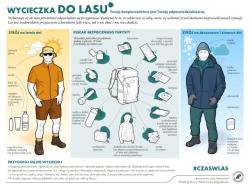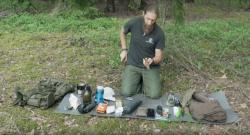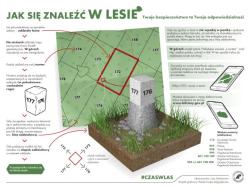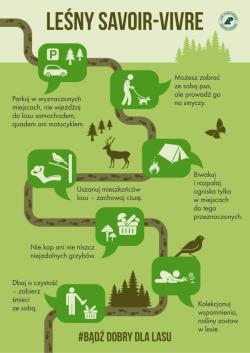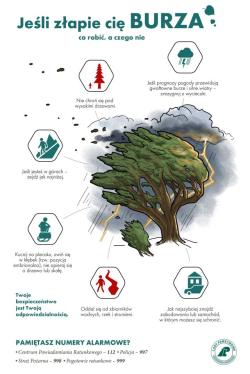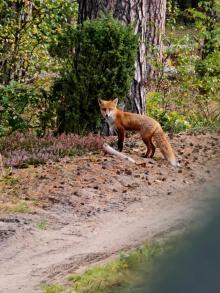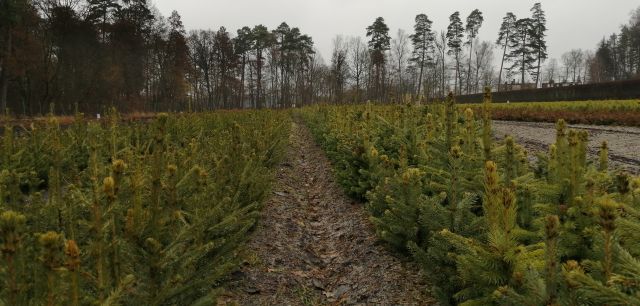 Asset Publisher
Asset Publisher
Polish forests
Poland is in the European lead, while concerning the area of all forests. They cover about 29,2 % of the country territory, and grow within the area of 9,1 million hectares. The overwhelming majority of the forests is state owned, of which almost 7,6 million hectares are managed by the State Forests National Forest Holding..
The number of Polish forest is still growing. The forestation rate of the country has increased from 21 % in 1945 to 29,2 % at the moment. Between 1995 and 2008, the forest area increased by 310 thousand ha. The basis for afforestation works is the "National Programme for Increasing the Forest Cover" (KPZL), assuming an increase of the forestation rate up to 30 % by 2020 and up to 33 % by 2050. Polish forests abound in flora, fauna and fungi. 65 % of the total number of animal species live there.
The forests grow in our country on poor soils, mainly because of the development of the agriculture in previous years. It influences the distribution of the types of the forest sites in Poland. Over 55 % of the forest areas is covered with coniferous forests. In other areas, there are forest sites, mainly the mixed ones. Their small part constitute alder and riparian forests – not more than 3 %.
In the years 1945 – 2011 the area of natural deciduous tree stands within the area of the State Forests National Forest Holding increased from 13 to 28,2 %.
Within the lowlands and uplands the most often occurring tee species is pine. It covers 64,3 % of the forest area of the State Forests National Forest Holding and 57,7 % of private and commune forests. In the mountains the predominant species is European spruce ( in the west) and European spruce with beech (in the east). Domination of pine is the result of carrying on sustainable forest management in the past. Once, the monocultures (crops or cultivations of one species) were the answer to the great demand of industry for wood. Such forests appeared to be quite fragile to climatic factors. They also were often the prey of pests' expansion.
In Polish forests, the share of other tree species, especially deciduous trees have been systematically increasing. The foresters have stepped aside from monocultures – that is why, they try to fit specific species of the forest stand to the natural stand, that would be proper for the given area. Thanks to that, in the years 1945 – 2011, the area of the deciduous tree stands within the lands of the State Forests National Forest Holding increased from 13 to 28,2 %. There occur more and more frequently the following tree species: oaks, ashes, maples, sycamore maples, elms, but also birches, beeches, alders, poplars, hornbeams, aspens, tilias and willows.
Our forests are the most often represented by the forest stands aged 40 to 80 years. The average age of the forest equals 60 years. More and more trees are of big size at the age over 80 years. Since the end of the Second World War, the forests' area has increased up to almost 1,85 million hectares.
Raport o stanie lasów w Polsce 2012
 Asset Publisher
Asset Publisher
Surwiwal i bushcraft
Surwiwal i bushcraft
Lasy Państwowe wyznaczyły specjalne obszary leśne o łącznej powierzchni ponad 65 tys. ha, gdzie miłośnicy bushcraftu i survivalu będą mogli uprawiać swoje hobby bez obaw o naruszenie ustawy o lasach.
Pilotażowy program ruszy w kilkunastu regionach Polski już 21 listopada.
– Efekty ocenimy za rok, ale to może być przełom. Usuwamy bariery niezrozumienia między różnymi grupami i wspólnie szukamy rozwiązań, które pozwolą wszystkim cieszyć się lasem w sposób bezpieczny dla nich i dla lasu – mówi Andrzej Konieczny, dyrektor generalny Lasów Państwowych.
– Wyznaczyliśmy łącznie 43 takie obszary na terenie 15 z 17 regionalnych dyrekcji, w sumie obejmujące ponad 65 tys. ha lasów. Najmniejszy z nich liczy 224 ha, największy – 5371 ha. Na całej powierzchni tych obszarów bushcrafterzy będą mogli uprawiać najważniejsze dla nich aktywności zgodnie z ustalonym regulaminem – wyjaśnia Andrzej Konieczny, który 21 października wydał stosowną decyzję. Lasy objęte pilotażowym programem wchodzą w skład umocowanych ustawowo tzw. leśnych kompleksów promocyjnych (jest ich w LP 25), które służyć mają m.in. testowaniu innowacyjnych, eksperymentalnych rozwiązań w zakresie gospodarki leśnej.
Dyrektor generalny określił, że okres pilotażu potrwa od 21 listopada 2019 r. do 23 listopada 2020 r. Ustalił też wzór regulaminu, który muszą stosować osoby chcące skorzystać z możliwości dostępnych w wyznaczonych obszarach leśnych. Najważniejsze, że w granicach tych obszarów będzie można biwakować w dowolnym miejscu w grupie do czterech osób i nie dłużej niż dwie noce z rzędu bez zgody nadleśnictwa (wystarczy je tylko uprzedzić o tym zamiarze pocztą elektroniczną). Biwakujący będą musieli potem przywrócić miejsce do stanu wyjściowego, przed wszystkim posprzątać po sobie – zgodnie z zasadą leave no trace (z ang. nie zostawiaj po sobie śladów).
Okres pilotażu ma pozwolić leśnikom, którzy nie znali bliżej tej formy rekreacji, przekonać się, że uprawianie survivalu i bushcraftu nie tworzy zagrożeń dla lasu i innych osób. Obszary objęte programem będą monitorowane: leśnicy i wolontariusze z grup bushcraftowych będą prowadzili obserwację, wywiady z napotkanymi turystami, ankiety internetowe. Leśnicy będą dbali też na przykład o to, by koła łowieckie w odpowiednim miejscu i czasie oznaczały tablicami teren polowania oraz będą szeroko uprzedzali wszystkich o planowanych polowaniach zbiorowych. Po upływie roku przyjdzie czas na ocenę, ile osób korzysta z tego rodzaju oferty, jak są do tego przygotowane, jaka ich część zachowuje się etycznie i przestrzega ustalonych zasad, czy i jaki wpływ na stan lasu ma uprawianie tego rodzaju hobby. Wnioski będą podstawą do wypracowania docelowych rozwiązań.
Zgodnie z zarządzeniem nr 155 Dyrektora Generalnego Lasów Państwowych z dnia 21 października 2019 roku, w Nadleśnictwie Osie także został wyznaczony obszar do uprawiania bushcraftu i surwiwalu, są to leśnictwa: Osie oraz fragment leśnictwa Nowa Rzeka .(mapa)
Regulamin korzystania z tych obszarów także dostępny będzie na stronie internetowej Nadleśnictwa Osie.
Zachęcamy do wypełnienia ankiety skierowanej do użytkowników lasów (turystów).
link: http://personal.ewaluacja.eu/index.php/364718?lang=pl
Źródło: RDLP w Toruniu


 fot. Paweł Fabijański
fot. Paweł Fabijański
 fot. Paweł Fabijański
fot. Paweł Fabijański
 fot. Paweł Fabijański
fot. Paweł Fabijański

